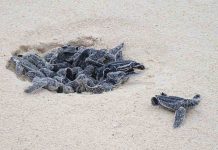
An egg-laying mammal named in honor of Sir David Attenborough has been rediscovered after it was thought extinct for more than 60 years.
This extremely strange animal is just one of two extant mammal species on Earth that lays eggs.
According to the conservation org Re:wild, it’s one of just five surviving species of monotreme, an ancient clade of egg-laying mammals found only in Australia and New Guinea, whose origins go back to the Jurassic era some 160 million years ago.
There are three long-beaked echidna species. One is critically endangered, but this one, Zaglossus attenboroughi, is known only from a single individual collected by a Dutch botanist during an expedition to the Cyclops Mountains in 1961.
“I was euphoric, the whole team was euphoric,” Dr. James Kempton told BBC News of the moment he spotted the Attenborough echidna in camera trap footage. “I’m not joking when I say it came down to the very last SD card that we looked at, from the very last camera that we collected, on the very last day of our expedition.”
It’s the stuff of dreams, and Kempton was able to telephone Sir David with the news, with the famous filmmaker saying he was “absolutely delighted.”
Lasting four weeks, the expedition included biologists from several universities from the UK and Czechia, Re:wild, and YAPPENDA, an Indonesian conservation-focused NGO.
The expedition was looking in some of the most remote rainforest on Earth in the northern highlands of the Indonesian half of New Guinea, and they also discovered a new frog species, several dozen new insects, and observed “healthy” populations of tree kangaroos as well as the most famous New Guinea residents: birds of paradise.
MORE NEWS LIKE THIS: ‘Like Finding a Unicorn’: Researchers Rediscover Black-Naped Pheasant-Pigeon, a Bird Lost to Science for 140 Years
In fact, the team found so much life, and worked closely alongside the native community who play a game of ‘seek the echidna’ as a form of feud resolution, that all the members came down certain the area needed to be protected.
“One of the goals of YAPPENDA is to ensure the preservation of the Cyclops Mountains and their remarkable biodiversity,” said Malcolm Kobak, cofounder of YAPPENDA. “To see photos of this endemic species is both encouraging and inspiring. The [echidna] holds a special place in the traditions of the Indigenous inhabitants of the Cyclops and is emblematic of Cyclops’ conservation efforts.”
MORE EXTINCT SPECIES RETURNING: Holly Tree Presumed Extinct for 200 Years Discovered After Placement on Most Wanted List: ‘Nature surprises us’
Re:wild was just one part of the expedition, but they’re getting used to this kind of good news and good press. Their “25 Most Wanted” initiative to document missing species has so far financed the rediscovery of 9 other animals from all the major orders around the world that have been presumed extinct.
These include Jackson’s climbing salamander, the silver-backed chevrotain, the Somali sengi, the velvet pitcher plant, Wallace’s giant bee, the Fernandina giant tortoise, Voeltzkow’s chameleon, the Pernambuco holly tree, and the Siera Leone crab.
WATCH the camera trap footage that set off the celebrations…
SHARE This Absolutely Great News For Nature With Your Friends…




















